Brisbane property market update March 2022
This article will highlight what has happened in the Brisbane property market throughout March 2022.

The Brisbane property market has performed strongly again throughout March 2022, maintaining its position as the fastest-growing capital city property market in the country. House price growth continues to outpace unit price growth; however, the gap is closing between the different product types. This article will explore what has been happening in the Brisbane property market throughout March 2022.
Supply in Brisbane remains tight, and off the back of the floods, it is possible that this trend will continue in the months ahead. Total advertised stock levels are -25.9 per cent lower than they were 12 months ago. This is also more than 40 per cent below the previous five-year average level. Even new listings are lower compared to the equivalent period last year.
Source: CoreLogic
When we compare listing volumes in Brisbane with those in Sydney and Melbourne, it is apparent that higher stock levels in the other major capital city markets have normalised. This can be explained by a larger volume of properties coming on the market in Sydney and Melbourne, in combination with a drop in buyer demand. This is very different to what we are experiencing in Brisbane.
Sales volumes in Brisbane are still very high. Compared to 12 months ago, Brisbane has seen an increase in the number of transactions across the city of 62.8 per cent. This is indicative of the high demand that has dominated our market in the period of time.
Change in Sales Volumes, 12 Months to February 2022 (Source: CoreLogic)
When we break down the sales volumes into a shorter period of time, analysing the last quarter instead of the last 12 months, according to CoreLogic, sales activity is 39 per cent lower than a year ago in Sydney and 27 per cent lower in Melbourne; however, sales volumes have increased in Brisbane over the same period. This is important to consider because our market is at a different stage in the cycle than these other major capital cities. It is another reason why we should never assume that Australia is “one property market”.
Over the month of March, auction clearance rates in Brisbane plummeted in the two weeks after the floods (42 per cent and 53 per cent) and then recovered. This can be explained by a sudden lack of buyer confidence as the city went into shock in relation to the impact that the heavy rain event had in many parts of the city. However, in the weeks that followed, buyer confidence slowly returned, and clearance rates, according to Domain, were back up to 64 per cent on the last weekend of March.
When we look at the trend in interstate migration, it is clear where the housing demand is coming from in Queensland. Throughout the September quarter, net migration into Queensland reached a new record high, equating to about 1,263 new residents every week. The graph below shows where most of those people were coming from.
Employment growth in Queensland has also been spectacular over the last 12 months. This is indicative of an improving economy off the back of the lockdowns and impacts relating to COVID-19 over the last two years.
The issue in Brisbane is where everyone is going to live if the population keeps growing rapidly? We already have extremely low vacancy rates, and listing volumes remain well below the long-term trends. The environment of low supply and high demand is likely to remain unchanged for some time yet, which will continue to support price growth in both dwelling values and rents.
Of course, we have to consider that inflation is rising, interest rates will increase at some stage in the near future, and consumer confidence has taken a turn for the worse over recent months. These factors will potentially have an impact on demand for some buyers, but at this stage, we are seeing no impact on the market because of this.
Brisbane property market prices
The latest Hedonic Home Value Index data by CoreLogic released on 1 April 2022 for the month of March 2022 has confirmed that the median dwelling value in Brisbane increased by a further +2 per cent over the month. This price growth is more than what we experienced in February. Whilst last month, we reported that a slowdown in the rate of growth across the city was starting to occur, this data suggests that this is no longer the case, with growth increasing again this month. The current median value for dwellings across Greater Brisbane is now $749,293, which is $26,860 higher than one month ago.
Annual growth for the last 12 months for Brisbane dwellings is now +29.3 per cent.